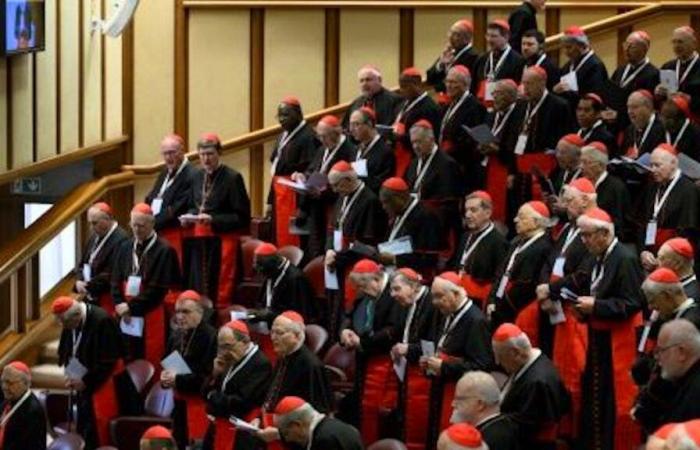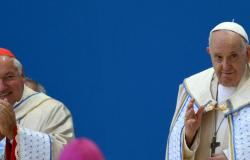During the beginner conclave on Wednesday, the cardinals voters will meet behind closed doors to elect a successor to pope Francis.
AFP
During the beginner conclave on Wednesday, the cardinals voters will meet in camera in the Sistine Chapel to elect in the greatest secrecy a successor to Pope Francis, who died on April 21 at 88.
Here is the progress of this vote, governed by the Apostolic Constitution Universi Dominici Gregis, enacted by John Paul II in 1996.
– Cardinals voters, those aged under the age of 80 (currently 135 in number, but two of them are absent for health reasons), are housed throughout the Conclave in the Sainte-Marthe residence in the Vatican.
– Monday, May 5, all those who must attend the conduct of the conclave – whether ecclesiastical or secular – take an oath in the Pauline chapel of the Apostolic Palace to keep secret.
– On the morning of the first day (May 7), the cardinals participate in a solemn mass in the Saint-Pierre basilica. They are asked to arrive at 9:15 am at the Saint-Sébastien chapel, where the tomb of John Paul II is located, to put on their liturgical outfit. This chapel is in the basilica, near the famous Pietà de Michel-Ange.
– In the afternoon, at 4:15 p.m., they meet in the Pauline chapel. The cardinals of the Latin Church wear, according to the Vatican, a red dress with belt, Rochet (a short dawn, editor’s note) Mosette (a short pilgrim), pectoral cross with red and gold cord, ring, cap and barrette “, while those of the oriental churches are dressed with their own ecclesiastical costumes.
– In the song of the Litania of the Saints, they then enter into a procession in the Sistine Chapel, whose isolation is scrupulously controlled.
– After the last liturgical song, Veni Creator, the cardinals take the oath.
– According to an immutable ritual inherited from the Middle Ages, the master of the celebrations pronounces the formula “Extra Omnes” (all outside). Those foreign to the votes leave.
– By drawing lots, three cardinals are designated “scrupoters”, three “infirmii” to collect the votes of the sick cardinals and three “revisers” who check the bulletins by the scrutines.
– Sitting side by side under the monumental fresco of the “Last Judgment” painted by Michelangelo, the cardinals receive bulletins of rectangular paper carrying the inscription “Eligo in Summum Pontificem” (“I elis like Sovereign Pontiff”) with an empty space below.
– The voters write by hand the name of their candidate, “of a writing not recognizable”, and fold the ballot twice. In theory, it is forbidden to vote for yourself.
– Each cardinal in turn goes to the altar, carrying his vote in the air so that he is clearly visible, and pronounces aloud the following oath in Latin: “I take witness to the Christ Lord, who will judge me, that I give my voice to that which, according to God, I think I should be elected.”
– He deposits his bulletin on a tray and makes him slide in the ballot box, in front of the scrupters, bows to the altar and returns to his place.
– Cardinals whose state of health or advanced age does not allow them to go to the altar put their vote to a scrutor, who deposited him in the ballot in their place.
– Once all the bulletins have been collected, a scanner agitates the urn to mix the bulletins, transfers them in a second container and then another makes the account.
– Two scanners note the names, while a third reads them aloud, piercing the bulletins with a needle through the word “Eligo” and connects them to each other. The revisers then check that the scrupoters did not make any mistakes.
– If no cardinal has obtained two thirds of the votes, the voters pass directly in a second round.
– With the exception of the first day, the cardinals carry out four ballots per day, two in the morning and two in the afternoon until a pope is proclaimed. After three days without result, the ballot is interrupted “for a maximum day, in order to give way to prayer” and “to a free exchange between voters”.
– Then other series of elections are organized until the final election.
– The bulletins of the two ballots and the notes taken by the cardinals are then destroyed, burned in a stove.
– The fireplace, visible by the faithful from Saint-Pierre square, emits black smoke if no pope has been elected and white smoke in the event of an election, by adding chemicals.
– The bells of the Saint-Pierre basilica sound to announce the news also.
– Once elected, it remains for the new pope to answer two questions from Cardinal Doyen: do you accept your canonical election as a sovereign pontiff?
What name do you want to be called? Responding “yes” to the first, the elected official becomes immediately Pope and bishop of Rome.
– One by one, the cardinals pay tribute and mark their obedience to the new Pope.
Next come the announcement to the faithful-“Habemus Papam”-by Cardinal Protodiacre, then the appearance of the new Pope and his Apostolic Blessing Urbi and Orbi from the Balcony of the Saint-Pierre Basilica.
(afp)








